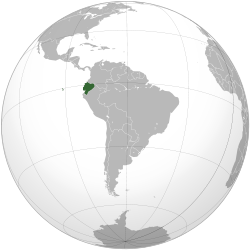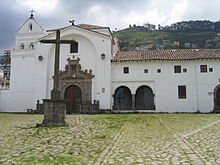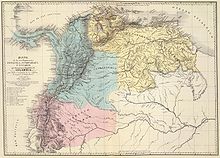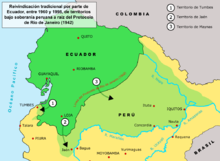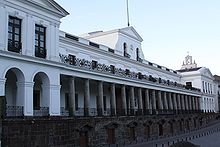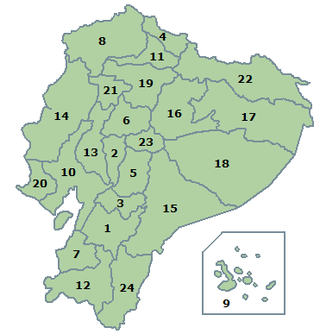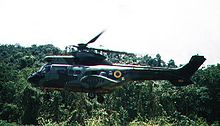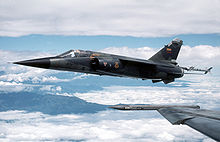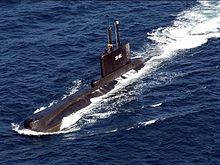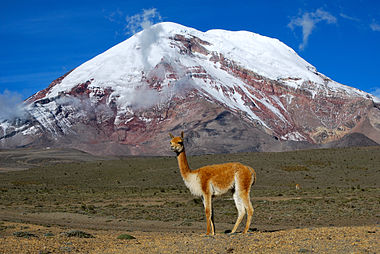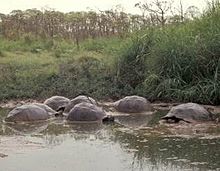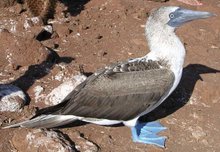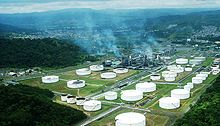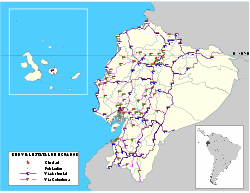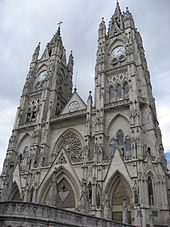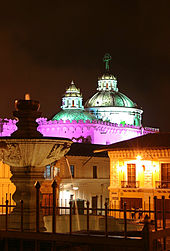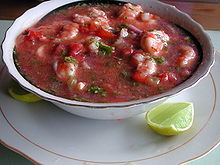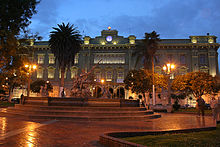- Ecuador
-
"Equador" redirects here. For the city in Brazil, see Equador, Rio Grande do Norte.
Republic of Ecuador República del Ecuador (Spanish)

Flag Coat of arms Motto: "Dios, patria y libertad" (Spanish)
"Pro Deo, Patria et Libertate" (Latin)
"God, homeland and liberty"Anthem: Salve, Oh Patria (Spanish)
Hail, Oh HomelandCapital Quito
00°9′S 78°21′W / 0.15°S 78.35°WLargest city Guayaquil Official language(s) Spanish1 Demonym Ecuadorian
Ecuadorean[1]Government Unitary presidential republic - President Rafael Correa - Vice President Lenín Moreno - President of the National Assembly Fernando Cordero Cueva Independence - declared August 10, 1809 - from Spain May 24, 1822 - from Gran Colombia May 13, 1830 - Recognized by Spain February 16, 1830 Area - Total 272,046 (with Galápagos) km2 (75th)
109,483 sq mi- Water (%) 5 Population - 2011 estimate 15,007,343[2] (65th) - 2010 census 14,306,876[3] - Density 53.8/km2 (151st)
139.4/sq miGDP (PPP) 2011 estimate - Total $119.963 billion[4] - Per capita $8,327[4] (92nd) GDP (nominal) 2011 estimate - Total $64,831 billion[4] (65th) - Per capita $4,921[4] (98th) Gini (2009) ▼49[5] (high) HDI (2011)  0.720[6] (high) (83th)
0.720[6] (high) (83th)Currency U.S. dollar2 ( USD)Time zone ECT, GALT (UTC−5, −6) Drives on the right ISO 3166 code EC Internet TLD .ec Calling code +593 1 Quechua and other Amerindian languages spoken by indigenous communities. 2 Sucre until 2000, followed by the U.S. dollar and Ecuadorian centavo coins Ecuador
 i/ˈɛkwədɔr/, officially the Republic of Ecuador (Spanish: República del Ecuador; pronounced: [re̞ˈpuβlika ðe̞l e̞kwaˈðo̞r], which literally translates to the Republic of the Equator) is a representative democratic republic in South America, bordered by Colombia on the north, Peru on the east and south, and by the Pacific Ocean to the west. It is one of only two countries in South America, along with Chile, that do not have a border with Brazil. The country also includes the Galápagos Islands in the Pacific, about 1,000 kilometres (620 mi) west of the mainland. The main spoken language in Ecuador is Spanish. Ecuador straddles the equator, from which it takes its name, and has an area of 272,046 km2 (105,038 sq mi). Its capital city is Quito, which was declared a World Heritage Site by UNESCO in the 1970s for having the best preserved and least altered historic centre in Latin America.[7] The country's largest city is Guayaquil. The historic centre of Cuenca, the third largest city in the country, was also declared a World Heritage Site in 1999, for being an outstanding example of a planned inland Spanish style colonial city in the Americas.[8] Ecuador is also home—despite its size—to a great variety of species, many of them endemic, like those of the Galápagos islands. This species diversity makes Ecuador one of the 17 megadiverse countries in the world.[9] The new constitution of 2008 is the first in the world to recognize legally enforceable Rights of Nature, or ecosystem rights.[10]
i/ˈɛkwədɔr/, officially the Republic of Ecuador (Spanish: República del Ecuador; pronounced: [re̞ˈpuβlika ðe̞l e̞kwaˈðo̞r], which literally translates to the Republic of the Equator) is a representative democratic republic in South America, bordered by Colombia on the north, Peru on the east and south, and by the Pacific Ocean to the west. It is one of only two countries in South America, along with Chile, that do not have a border with Brazil. The country also includes the Galápagos Islands in the Pacific, about 1,000 kilometres (620 mi) west of the mainland. The main spoken language in Ecuador is Spanish. Ecuador straddles the equator, from which it takes its name, and has an area of 272,046 km2 (105,038 sq mi). Its capital city is Quito, which was declared a World Heritage Site by UNESCO in the 1970s for having the best preserved and least altered historic centre in Latin America.[7] The country's largest city is Guayaquil. The historic centre of Cuenca, the third largest city in the country, was also declared a World Heritage Site in 1999, for being an outstanding example of a planned inland Spanish style colonial city in the Americas.[8] Ecuador is also home—despite its size—to a great variety of species, many of them endemic, like those of the Galápagos islands. This species diversity makes Ecuador one of the 17 megadiverse countries in the world.[9] The new constitution of 2008 is the first in the world to recognize legally enforceable Rights of Nature, or ecosystem rights.[10]Ecuador is a presidential republic and became independent in 1830, after having been part of the Spanish colonial empire and the republic of Gran Colombia. It is a medium-income country with an HDI score of 0.695 (2010),[6] and about 35.1% of its population lives below the poverty line.[11]
Contents
History
Many civilizations rose throughout Ecuador, such as the Valdivia Culture and Machalilla Culture on the coast, the Quitus (near present day Quito) and the Cañari (near present day Cuenca). Each civilization developed its own distinctive architecture, pottery, and religious interests, although consolidated under a confederation called the Shyris which exercised organized trading and bartering between the different regions and whose political and military power was under the rule of the Duchicela blood line before the Inca invasion. After years of fiery resistance by the Cañaris and other tribes, as demonstrated by the battle of Yahuarcocha (Blood Lake) where thousands of resistance fighters were killed and thrown in the lake, the region fell to the Incan expansion and was assimilated loosely into the Incan empire.
Inca Empire
Through a succession of wars and marriages among the nations that inhabited the valley, the region became part of the Inca Empire in 1463. When the Spanish conquistadors arrived from the north, the Inca Empire was ruled by Huayna Capac, who had two sons: Atahualpa, being in charge of the northern parts of the empire, and Huáscar, seated in the Incan capital Cusco. Upon Huayna Capac's death in 1525, the empire was divided in two: Atahualpa received the north, with his capital in Quito; Huáscar received the south, with its capital in Cusco. In 1530, Atahualpa defeated his own brother, Huáscar, and claimed control over the entire empire. Atahualpa's victory was short-lived as he was soon captured by the Spanish conquistadors in Cajamarca, and later executed for the murder of his brother.
Colonization
Disease decimated the indigenous population during the first decades of Spanish rule — a time when the natives also were forced into the encomienda labor system for the Spanish. In 1563, Quito became the seat of a real audiencia (administrative district) of Spain and part of the Viceroyalty of Peru, and later the Viceroyalty of New Granada.
After nearly 300 years of Spanish colonization, Quito was still a small city of only 10,000 inhabitants. It was here, on August 10, 1809, that the first call for independence from Spain was made in Latin America, under the leadership of the city's criollos like Juan Pío Montúfar, Quiroga, Salinas, and Bishop Cuero y Caicedo. Quito's nickname, "Luz de América" ("Light of America"), comes from the fact that this was the first successful attempt to produce an independent and local government, although for no more than two months, having important repercussions and inspiration for the emancipation of the rest of Spanish America.
Independence
On October 9, 1820, Guayaquil became the first city in Ecuador to gain its independence from Spain. On May 24, 1822, the rest of Ecuador gained its independence after Antonio José de Sucre defeated the Spanish Royalist forces at the Battle of Pichincha, near Quito. Following the battle, Ecuador joined Simón Bolívar's Republic of Gran Colombia – joining with modern day Colombia and Venezuela – only to become a republic in 1830.
The 19th century for Ecuador was marked by instability, with a rapid succession of rulers. The first president of Ecuador was the Venezuelan-born Juan José Flores, who was ultimately deposed, followed by many authoritarian leaders such as Vicente Rocafuerte; José Joaquín de Olmedo; José María Urbina; Diego Noboa; Pedro José de Arteta; Manuel de Ascásubi; and Flores's own son, Antonio Flores Jijón, among others. The conservative Gabriel Garcia Moreno unified the country in the 1860s with the support of the Roman Catholic Church. In the late 19th century, world demand for cocoa tied the economy to commodity exports and led to migrations from the highlands to the agricultural frontier on the coast.
Liberal Revolution
Main article: Liberal Revolution of 1895The coast-based Liberal Revolution of 1895 under Eloy Alfaro reduced the power of the clergy and the conservative land owners of the highlands, and this liberal wing retained power until the military "Julian Revolution" of 1925. The 1930s and 1940s were marked by instability and emergence of populist politicians, such as five-time President José María Velasco Ibarra.
War with Peru
The Ecuadorian–Peruvian territorial disputeHistory of the Ecuadorian–Peruvian territorial dispute
Gran Colombia–Peru War (1828-1829)
Ecuadorian–Peruvian territorial dispute of 1857-1860
Ecuadorian-Peruvian War (1941)
Paquisha War (1981)
Cenepa War (1995)Control over territory in the Amazon basin led to a long-lasting dispute between Ecuador and Peru. In 1941, amid fast-growing tensions between the two countries, war broke out. Peru claimed that Ecuador's military presence in Peruvian-claimed territory was an invasion; Ecuador, for its part, claimed that Peru had invaded Ecuador. In July 1941, troops were mobilized in both countries. Peru had an army of 11,681 troops who faced a poorly supplied and inadequately armed Ecuadorian force of 2,300, of which only 1,300 were deployed in the southern provinces. Hostilities erupted on July 5, 1941, when Peruvian forces crossed the Zarumilla river at several locations, testing the strength and resolve of the Ecuadorian border troops. Finally, on July 23, 1941, the Peruvians launched a major invasion, crossing the Zarumilla river in force and advancing into the Ecuadorian province of El Oro.
During the course of the war, Peru gained control over part of the disputed territory and some parts of the province of El Oro, and some parts of the province of Loja, demanding that the Ecuadorian government give up its territorial claims. The Peruvian Navy blocked the port of Guayaquil, almost cutting all supplies to the Ecuadorian troops. After a few weeks of war and under pressure by the United States and several Latin American nations, all fighting came to a stop. Ecuador and Peru came to an accord formalized in the Rio Protocol, signed on January 29, 1942, in favor of hemispheric unity against the Axis Powers in World War II favoring Peru with the territory they occupied at the time the war came to an end.
Recession and popular unrest led to a return to populist politics and domestic military interventions in the 1960s, while foreign companies developed oil resources in the Ecuadorian Amazon. In 1972, construction of the Andean pipeline was completed. The pipeline brought oil from the east side of the Andes to the coast, making Ecuador South America's second largest oil exporter. The pipeline in southern Ecuador did nothing, however, to resolve tensions between Ecuador and Peru.
The Rio Protocol failed to precisely resolve the border along a small river in the remote Cordillera del Cóndor region in southern Ecuador. This caused a long-simmering dispute between Ecuador and Peru, which ultimately led to fighting between the two countries; first a border skirmish in January–February 1981 known as the Paquisha Incident, and ultimately full-scale warfare in January 1995 where the Ecuadorian military shot down Peruvian aircraft and helicopters and Peruvian infantry marched into southern Ecuador. Each country blamed the other for the onset of hostilities, known as the Cenepa War. Sixto Durán Ballén, the Ecuadorian president, famously declared that he would not give up a single centimeter of Ecuador. Popular sentiment in Ecuador became strongly nationalistic against Peru: graffiti could be seen on the walls of Quito referring to Peru as the "Cain de Latinoamérica", a reference to the murder of Abel by his brother Cain in the Book of Genesis.[12]
Ecuador and Peru reached a tentative peace agreement in October 1998, which ended hostilities, and the Guarantors of the Rio Protocol ruled that the border of the undelineated zone was set the line of the Cordillera del Cóndor. While Ecuador had to give up its decades-old territorial claims to the eastern slopes of the Cordillera, as well as to the entire western area of Cenepa headwaters, Peru was compelled to give to Ecuador, in perpetual lease but without sovereignty, one square kilometre of its territory, in the area where the Ecuadorian base of Tiwinza — focal point of the war — had been located within Peruvian soil and which the Ecuadorian Army held as their strong hold all the time during the conflict. The final border demarcation came into effect on May 13, 1999.
Military governments (1972–1979)
In 1972, a "revolutionary and nationalist" military junta overthrew the government of Velasco Ibarra. The coup d'état was led by General Guillermo Rodríguez and executed by navy commander Jorge Queirolo G. The new president exiled José María Velasco to Argentina. He remained in power until 1976, when he was removed by another military government. That military junta was led by Admiral Alfredo Poveda, who was declared chairman of the Supreme Council. The Supreme Council included two other members: General Guillermo Durán Arcentales and General Luis Leoro Franco. The civil society more and more insistently called for democratic elections. Colonel Richelieu Levoyer, Government Minister, proposed and implemented a Plan to return to the constitutional system through universal elections. This Plan enabled the new democratically elected president to assume the duties of the executive office.
Return to democracy
Elections were held on April 29, 1979, under a new constitution. Jaime Roldós Aguilera was elected president, garnering over one million votes, the most in Ecuadorian history. He took office on August 10 as the first constitutionally elected president after nearly a decade of civilian and military dictatorships. In 1980, he founded the Partido Pueblo, Cambio y Democracia (People, Change and Democracy Party) after withdrawing from the Concentracion de Fuerzas Populares (Popular Forces Concentration) and governed until May 24, 1981, when he died along with his wife and the minister of defense, Marco Subia Martinez, when his Air Force plane crashed in heavy rain near the Peruvian border. Many people believe that he was assassinated,[citation needed] given the multiple death threats leveled against him because of his reformist agenda, deaths in automobile crashes of two key witnesses before they could testify during the investigation and the sometimes contradictory accounts of the incident.
Roldos was immediately succeeded by Vice President Osvaldo Hurtado who was followed in 1984 by León Febres Cordero from the Social Christian Party. Rodrigo Borja Cevallos of the Democratic Left (Izquierda Democrática or ID) party won the presidency in 1988, running in the runoff election against Abdalá Bucaram (brother in law of Jaime Roldos and founder of the Ecuadorian Roldosist Party). His government was committed to improving human rights protection and carried out some reforms, notably an opening of Ecuador to foreign trade. The Borja government concluded an accord leading to the disbanding of the small terrorist group, "¡Alfaro Vive, Carajo!" ("Alfaro Lives, Dammit!") named after Eloy Alfaro. However, continuing economic problems undermined the popularity of the ID, and opposition parties gained control of Congress in 1990.
The emergence of the indigenous population (approximately 25%) as an active constituency has added to the democratic volatility of the country in recent years. The population has been motivated by government failures to deliver on promises of land reform, lower unemployment and provision of social services, and historical exploitation by the land-holding elite. Their movement, along with the continuing destabilizing efforts by both the elite and leftist movements, has led to a deterioration of the executive office. The populace and the other branches of government give the president very little political capital, as illustrated by the most recent removal of President Lucio Gutiérrez from office by Congress in April 2005. Vice President Alfredo Palacio took his place and remained in office until the presidential election of 2006, in which Rafael Correa gained the presidency.
On September 30, 2010, in a police revolt, many police officers were killed after a military intervention in a police hospital. President Rafael Correa alleged that he was taken hostage in the hospital by police officers as part of a series of protests against cuts to the benefits of public service workers that were part of a financial austerity package. What angered police and elements of the army was a law to end the practice of giving medals and bonuses with each promotion. It would also extend from five to seven years the usual period required for promotions. The government called the revolt a coup and declared a one-week state of emergency which put the military in charge of public order and suspended civil liberties. Peru shut its border with Ecuador.[13] Numerous social movements claim that civil rights have been violated by the government.
Politics
Ecuador is governed by a democratically elected President, for a four year term. The current president of Ecuador, Rafael Correa, exercises his power from the presidential Palacio de Carondelet in Quito. The current constitution was written by the Ecuadorian Constituent Assembly elected in 2007, and was approved by referendum in 2008.
The executive branch includes 25 ministries. Provincial governors and councilors (mayors, aldermen, and parish boards) are directly elected. The National Assembly of Ecuador meets throughout the year except for recesses in July and December. There are thirteen permanent committees. Justices of the National Court are appointed by the Council of Social Participation, for nine year terms.
Ecuador has often placed great emphasis on multilateral approaches to international issues. Ecuador is a member of the United Nations (and most of its specialized agencies) and a member of many regional groups, including the Rio Group, the Latin American Economic System, the Latin American Energy Organization, the Latin American Integration Association, the Bolivarian Alliance for the Peoples of Our America, the Andean Community of Nations and the Union of South American Nations (UNASUR).
Administrative divisions
Ecuador is divided into 24 provinces (Spanish: provincias), each with its own administrative capital:
Administrative divisions of Ecuador Province Surface (km²) Population (2010)[14] Capital 1 Azuay 8,639 702,893 Cuenca 2 Bolivar 3,254 182,744 Guaranda 3 Cañar 3,908 223,463 Azogues 4 Carchi 3,699 165,659 Tulcan 5 Chimborazo 5,287 452,352 Riobamba 6 Cotopaxi 6,569 406,798 Latacunga 7 El Oro 5,988 588,546 Machala 8 Esmeraldas 15,216 520,711 Esmeraldas 9 Galápagos 8,010 22,770 Puerto Baquerizo Moreno 10 Guayas 17,139 3,573,003 Guayaquil 11 Imbabura 4,599 400,359 Ibarra 12 Loja 11,027 446,743 Loja 13 Los Rios 6,254 765,274 Babahoyo 14 Manabi 18,400 1,345,779 Portoviejo 15 Morona Santiago 25,690 147,886 Macas 16 Napo 13,271 104,047 Tena 17 Orellana 20,773 137,848 Puerto Francisco de Orellana 18 Pastaza 29,520 84,329 Puyo 19 Pichincha 9,494 2,570,201 Quito 20 Santa Elena 3,763 301,168 Santa Elena 21 Santo Domingo de los Tsachilas 3,857 365,965 Santo Domingo 22 Sucumbios 18,612 174,522 Nueva Loja 23 Tungurahua 3,334 500,775 Ambato 24 Zamora Chinchipe 10,556 91,219 Zamora The provinces are divided into cantons, and further subdivided into parishes (parroquias).
Military
The Ecuadorian Armed Forces (Fuerzas Armadas del Ecuador), consisting of the Army, Air Force and Navy, have responsibility for the preservation of the integrity and national sovereignty of the national territory.
The military tradition starts in the Gran Colombia, where a sizeable army was stationed in Ecuador due to border disputes with Peru, which claimed territories under its political control when it was a Spanish vicerroyalty. Once the Gran Colombia was dissolved after the death of Simón Bolívar in 1830, Ecuador inherited the same border disputes and had the need of creating its own professional military force. So influential was the military in Ecuador in the early republican period, that its first decade was under the control of Gral. Juan Jose Flores, first president of Ecuador of Venezuelan origin. The Gral. Jose Ma. Urbina and Gral. Robles are examples of military figures who became president of the country in the early republican period.
Due to the continuous border disputes with Peru, finally settled in the early 2000s, and due to the ongoing problem with the Colombian guerrilla insurgency infiltrating Amazonian provinces, the Ecuadorian Armed Forces has gone through a series of changes as an essential part of the country's existence. In 2009, the new administration at the Defense Ministry launched a deep restructuring within the forces, increasing spending budget to $1,691,776,803, an increase of 25%. (FY08)[15]
The icons of the Ecuadorian military forces are the Marshall Antonio José de Sucre and Gral. Eloy Alfaro. The Military Academy "Gral. Eloy Alfaro" (c. 1838) graduates the army officers and is located in Quito.[16] The Ecuadorian Navy Academy (c. 1837) located in Salinas graduates the navy officers,[17] and the Air Academy "Cosme Rennella" (c.1920) located in Salinas, graduates the air force officers.[18] Other training academies for different military specialties are found across the country.
Geography
Ecuador lies between latitudes 2°N and 5°S, and longitudes 75° and 92°W.
The country has three main geographic regions, plus an insular region in the Pacific Ocean:
- La Costa, or the coast, comprises the low-lying land in the western part of the country, including the Pacific coastline.
- La Sierra, ("the highlands") is the high-altitude belt running north-south along the centre of the country, its mountainous terrain dominated by the Andes mountain range.
- La Amazonía, also known as El Oriente ("the east"), comprises the Amazon rainforest areas in the eastern part of the country, accounting for just under half of the country's total surface area, though populated by less than 5% of the population.
- The Región Insular is the region comprising the Galápagos Islands, some 1,000 kilometres (620 mi) west of the mainland in the Pacific Ocean.
Ecuador's capital is Quito, which is in the province of Pichincha in the Sierra region. Its largest city is Guayaquil, in the Guayas Province. Cotopaxi, which is just south of Quito, features one of the world's highest active volcanoes. The top of Mount Chimborazo (6,310 m above sea level) is considered to be the most distant point from the centre of the earth, given the ovoid shape of the planet.[21]
Climate
There is great variety in the climate, largely determined by altitude. It is mild year-round in the mountain valleys; Humid Subtropical Climate incoastal and Rain Forests in lowlands. The Pacific coastal area has a tropical climate, with a severe rainy season. The climate in the Andean highlands is temperate and relatively dry; and the Amazon basin on the eastern side of the mountains shares the climate of other rain forest zones.
Because of its location at the equator, Ecuador experiences little variation in daylight hours during the course of a year. Both sunrise and sunset occur each day at the two six o'clock hours.[22]
Biodiversity
Ecuador is one of 17 megadiverse countries in the world according to Conservation International,[9] and it has the most biodiversity per square kilometer of any nation.[23] In addition to the mainland, Ecuador owns the Galápagos Islands, for which the country is best known.[24]
Ecuador has 1,600 bird species (15% of the world's known bird species) in the continental area, and 38 more endemic in the Galápagos. In addition to over 16,000 species of plants, the country has 106 endemic reptiles, 138 endemic amphibians, and 6,000 species of butterfly. The Galápagos Islands are well known as a region of distinct fauna, famous as the place of birth of Darwin's Theory of Evolution, and a UNESCO World Heritage Site.[25]
Ecuador has the first constitution to recognize the rights of nature.[26] The protection of the nation's biodiversity is an explicit national priority as stated in the National Plan of "Buen Vivir", or good living, objective 4, Guarantee the rights of nature, policy 1: "Sustainably conserve and manage the natural heritage including its land and marine biodiversity which is considered a strategic sector".[27] As of the writing of that Plan in 2008, 19% of Ecuador's land area was in a protected area, however, the Plan also states that 32% of the land must be protected in order to truly preserve the nation's biodiversity.[23] Current protected areas include 11 national parks, 10 wildlife refuges, 9 ecological reserves and other areas.[28] A program begun in 2008, Sociobosque, is preserving another 2.3% of total landarea (629,475.5 hectares or 6,295 km²) by paying private landowners or community landowners (such as indigenous tribes) incentives to maintain their land as native ecosystems such as native forests or grasslands. Eligibility and subsidy rates for this program are determined based on the poverty in the region, the number of hectacres that will be protected, the type of ecosystem of the land to be protected among other factors.[29]
Despite being on the UNESCO list, the Galápagos are endangered by a range of negative environmental effects, threatening the existence of this exotic ecosystem.[30] Additionally, oil exploitation of the Amazon rain forest has led to the release of billions of gallons of untreated wastes, gas, and crude oil into the environment, contaminating ecosystems and causing detrimental health effects to indigenous peoples.[31]
Economy
Ecuador's economy has heavily depended on exporting resources such as petroleum, fish, shrimp, timber and gold. In addition, it has rich agriculture: bananas, flowers, coffee, cacao, guayusa, sugar, tropical fruits, palm oil, palm hearts, rice, roses, and corn.[32] The country´s greatest national export is crude oil.[33] Fluctuations in world market prices can have a substantial domestic impact. Industry is largely oriented to servicing the domestic market, with some exports to the Andean Community of Nations.
Deteriorating economic performance in 1997–98 culminated in a severe economic and financial crisis in 1999. The crisis was precipitated by the El Niño weather phenomenon in 1997, a sharp drop in global oil prices in 1997–98, and international emerging market instability in 1997–98. These factors resulted in a 7.3% contraction of GDP, annual year-on-year inflation of 52.2%, and a 65% devaluation of the national currency, the Sucre, in 1999, which helped precipitate a default on external loans later that year. In January 2000, President Jamil Mahuad announced a policy to adopt the U.S. dollar as the official currency of Ecuador, and although Mahuad was forced from office, his successor Gustavo Noboa continued with the plan, and also entered into negotiations with the IMF.
Transportation
Ecuador has a network of national highways maintained by the Ministerio de Obras Públicas y Comunicaciones (Ministry of Public Works and Communication). The Pan-American Highway connects the northern and southern portions of the country as well as connecting Ecuador with Colombia to the north and Peru to the south. The quality of roads, even on truck routes, is highly variable.
There is an extensive network of intercity buses that use these mountain roads and highways. The most modern Ecuadorian Highway connects Guayaquil with Salinas.
The Empresa de Ferrocarriles Ecuatorianos is the Ecuadorian national railway. The Interandean Railroad is essentially defunct; only the short "devil's nose" section is usable. Tourists usually board the train in Alausí, although some opt for a longer trip from Riobamba (if available).
Demographics
2011 estimates put Ecuador's population at 15,007,343.[34] CIA World Factbook gives the flowing statistics: "mestizo (mixed Amerindian and white) 65%, Amerindian 25%, Spanish and others 7%, black 3%".[35] Ecuador's population is ethnically diverse. The largest ethnic group (as of 2007) is the Mestizos, who are the descendants of Spanish colonists and the indigenous people which constitute 65% of the population based on a self-determined census. Amerindians account for 25% of the current population. The unmixed descendants of early Spanish colonists, independently of their ethnic Iberian or Mediterranean origin called "Criollos", as well as immigrants from other European countries account for about 7% of the population. Afro-Ecuadorians, including Mulattos and zambos, are also a minority, are largely based in Esmeraldas and Imbabura provinces, and make up 3% of the population.[35]
Religion
Approximately 95% of Ecuadorians are Roman Catholic (see List of Roman Catholic dioceses in Ecuador), and 5% belong to other religious denominations including Protestants.[35] In the rural parts of Ecuador, indigenous beliefs and Catholicism are sometimes syncretized. Most festivals and annual parades are based on religious celebrations, many incorporating a mixture of rites and icons.
The Jewish community of Ecuador, maintains a synagogue, a school and a home for the aged in Quito.[citation needed] There is a small number of Eastern Orthodox Christians, indigenous religions, Muslims (see Islam in Ecuador), Buddhists and Bahá'í. Ecuador has a number of members of The Church of Jesus Christ of Latter-day Saints, about 1.4% of the population or about 185,000 members.[36][37] In 2010, there were 73,215 Jehovah's Witnesses in the country.[38]
Population density
The majority of Ecuadorians live in the central provinces in land the Andes mountains or along the Pacific coast. The tropical forest region to the east of the mountains (El Oriente) remains sparsely populated and contains only about three percent of the population.
Population cities (2010)[14]Largest cities
Rank City Province Population
1 Guayaquil Guayas 2,600,000 2 Quito Pichincha 2,100,000 3 Cuenca Azuay 550,000 4 Santo Domingo de los Colorados Santo Domingo de los Tsáchilas 305,000 5 Machala El Oro 240,000 6 Durán Guayas 235,000 7 Portoviejo Manabí 225,000 8 Manta Manabí 217,000 9 Loja Loja 185,000 10 Ambato Tungurahua 178,000 Nations
The Ecuadorian constitution recognizes the "pluri-nationality" of those who want to exercise their affiliation with their native ethnic groups. Therefore, in addition to criollos, mestizos, and Afro-Ecuadorians, some people belong to the indigenous nations scattered in a few places in the coast, Quechua Andean villages, and the Amazonian jungle.
Immigration and emigration
See also: Emigration from EcuadorA small east Asian Latino community estimated at 2,500 mainly consists of those of Japanese and Chinese descent, whose ancestors arrived as miners, farm hands and fishermen in the late 19th century.[39]
In the early years of World War II, Ecuador still admitted a certain number of immigrants, and in 1939, when several South American countries refused to accept the 165 Jewish refugees from Germany aboard the ship "Koenigstein", Ecuador granted them entry permits.
Culture
Ecuador's mainstream culture is defined by its Hispanic mestizo majority and, like their ancestry, is traditionally of Spanish heritage influenced at different degrees with Amerindian traditions and in some cases with African elements.The first and most substantial wave of modern immigration to Ecuador consisted of Spanish colonists, following the arrival of Europeans in 1499. However a low number of other Europeans and North Americans migrated to the country in the late 19th and early twentieth centuries, and, in smaller numbers, Poles, Lithuanians, English, Irish, and Croats during and after the Second World War. Since African slavery was not the workforce of the Spanish colonies in the "Terra Firme" (South-America) given the subjugation of the indigenous people through evangelism and encomiendas, the minor African descendant elements are found in the northern provinces of Esmeraldas and Imbabura thanks to the 17th century shipwreck of a slave-trading galleon in front of the northern coast of Ecuador. The few black African survivors swam to the shore and penetrated the then thick jungle under the leadership of Anton, the chief of the group, where they remained as free-men while maintaining their original culture not influenced by the typical elements found on other provinces of the coast or in the Andean region.
Ecuador's indigenous communities are integrated into the mainstream culture to varying degrees,[40] but some may also practice their own indigenous cultures, particularly the more remote indigenous communities of the Amazon basin. Spanish is spoken as the first language by more than 90% of the population and as a first or second language by more than 98%. One part of Ecuador's population can speak Amerindian languages, in some cases as a second language. Two percent of the population speak only Amerindian languages.
Cuisine
Ecuadorian ceviche, made of shrimp, lemon. Tomato sauce is used at some places, but does not form a part of the recipe
Ecuadorian cuisine is diverse, varying with altitude and associated agricultural conditions. Most regions in Ecuador follow the traditional three course meal of soup, a second course which includes rice and a protein such as meat or fish, and then dessert and coffee to finish. Supper is usually lighter and sometimes consists only of coffee or herbal tea with bread.
In the highland region, pork, chicken, beef, and cuy (guinea pig) are popular and are served with a variety of grains (especially rice and corn) or potatoes.
In the coastal region seafood is very popular, with shrimp and cerviche being key parts of the diet. Plantain- and peanut-based dishes are the basis of most coastal meals. Churrasco is a staple food of the Coast Region specially Guayaquil. Arroz con menestra y carne asada (rice with beans and grilled beef) is one of the traditional dishes of Guayaquil, as is fried plantain which is often served with it.
In the Amazon region, a dietary staple is the yuca, elsewhere called cassava. Many fruits are available in this region, including bananas, tree grapes, and peach palms. This region is a lead producer of bananas, cacao beans (to make chocolate), shrimp, tilapia, mangos and passion fruit, among other products.
Literature
Early literature in colonial Ecuador, as in the rest of Spanish America, was influenced by the still existing tendencies of the Spanish Golden Age. One of the earliest examples is Jacinto Collahuazo,[41] an indigenous chief of a northern village in today's Ibarra born in the late 1600s. Despite of the early repression and discrimination of the native people by the Spanish, Jacinto learned to read and write in Castilian but his work was written in Quechua.[42] Collahuazo was imprisoned, and all of his work burned. The existence of his literary work came to light many centuries later, while a crew of masons were restoring the walls of a colonial church in Quito and found a hidden manuscript. The salvaged fragment is a Spanish translation from Quechua of the "Elegy to the Dead of Atahualpa",[41] a poem written by Collahuazo, which describes the sadness and impotence of the Inca people of having lost their king Atahualpa.
Other early Ecuadorian writers include the Jesuits Juan Bautista Aguirre, born in Daule in 1725, and Father Juan de Velasco, born in Riobamba in 1727. Juan de Velasco wrote about the nations and chiefdoms which existed in the Kingdom of Quito (today Ecuador) before the arrival of the Spanish. His historical accounts are nationalistic, featuring a romantic perspective of pre-colonial history.
Famous authors from the late colonial and early republic period include: Eugenio Espejo a printer and main author of the first newspaper in Ecuadorian colonial times; Jose Joaquin de Olmedo (born in Guayaquil), famous for his ode to Simón Bolívar titled Victoria de Junin; Juan Montalvo, a prominent essayist and novelist; Juan Leon Mera, famous for his work "Cumanda" or "Tragedy among Savages" and the Ecuadorian National Anthem; Juan A. Martinez with A la Costa, Dolores Veintimilla,[43] and others.
Contemporary Ecuadorian writers include the novelist Jorge Enrique Adoum; the poet Jorge Carrera Andrade; the essayist Benjamín Carrión; the poets Medardo Angel Silva, Jorge Carrera Andrade; the novelist Enrique Gil Gilbert; the novelist Jorge Icaza (author of the novel Huasipungo, translated to many languages); the short story author Pablo Palacio; the novelist Alicia Yanez Cossio.
-
Juan Montalvo, Ambato
-
Luis Alberto Costales, Riobamba
Art
The best known art tendencies from Ecuador belonged to the Escuela Quiteña, which developed from the 16th to 18th centuries, examples of which are on display in various old churches in Quito. Ecuadorian painters include: Oswaldo Guayasamín, Camilo Egas and Eduardo Kingman from the Indiginist Movement; Manuel Rendon, Jaime Zapata, Enrique Tábara, Aníbal Villacís, Theo Constanté, León Ricaurte and Estuardo Maldonado from the Informalist Movement; and Luis Burgos Flor with his abstract, Futuristic style. The indigenous people of Tigua, Ecuador are also world renowned for their tradicional paintings.
Sport
The most popular sport in Ecuador, as in most South American countries, is football (soccer). Its best known professional teams include Barcelona and Emelec from Guayaquil; LDU Quito, Deportivo Quito, and El Nacional from Quito; Olmedo from Riobamba; and Deportivo Cuenca from Cuenca. Currently the most successful football club in Ecuador is LDU Quito and it is the only Ecuadorian club that have won the Copa Libertadores, the Copa Sudamericana and the Recopa Sudamericana, they were also runners-up in the 2008 FIFA Club World Cup. The matches of the Ecuadorian national team are the most watched sporting events in the country. Ecuador qualified for the final rounds of both the 2002 and 2006 FIFA World Cups. The 2002 FIFA World Cup qualifying campaign was considered a huge success for the country and for its inhabitants, because it was said that it had changed the people's point of view and mentality of goals that used to be very hard to achieve for Ecuadorians and now they seem much possible; Ecuador finished in 2nd place on the qualifiers behind Argentina and above the team that would become World Champion, Brazil. In the 2006 FIFA World Cup, Ecuador finished ahead of Poland and Costa Rica to come in second to Germany in Group A in the 2006 World Cup. Futsal, often referred to as índor, is particularly popular for mass participation.
There is considerable interest in tennis in the middle and upper classes in Ecuadorian society, and several Ecuadorian professional players have attained international fame. Basketball has a high profile, while Ecuador's specialties include Ecuavolley, a three-person variation of volleyball. Bullfighting is practiced at a professional level in Quito, during the annual festivities that commemorate the Spanish founding of the city, and also features in festivals in many smaller towns. Rugby union is found to some extent in Ecuador, with teams in Guayaquil,[44] Quito,[45] and Cuenca.
Ecuador has won only two medals in the Olympic Games, both gained by 20 km racewalker Jefferson Pérez, who took gold in the 1996 games and silver 12 years later. Pérez also set a world best in the 2003 World Championships of 1:17:21 for the 20 km distance.[46]
Health
Main article: Health in EcuadorThe current structure of the Ecuadorian public health care system dates back to 1967.[47][48] The Ministry of the Public Health (Ministerio de Salud Publica del Ecuador) is the responsible entity of the regulation and creation of the public health policies and health care plans. The "Minister of Public Health" is appointed directly by the President of the republic. His current "ministro", or Ecuadorian general surgeon, is Dr. David Chiriboga, an specialist and investigator in communitarian medicine.[49]
The philosophy of the Ministry of Public Health is the social support and service to the most vulnerable population[50] and its main plan of action lies around communitarian health and preventive medicine.[50]
The public health care system allows patients to be attended daily in public general hospitals, with no previous appointment, by general practitioners and specialists in the "Consulta Externa" (External Consultation) at no cost. This is done in the 4th basic specialties of pediatric, gynecology, clinic medicine, and surgery.[51] There are also public hospitals specialized to treat chronic diseases, target a particular group of the population, or to provide a better attention in some medical specialties. Some examples in this group are the Gynecologic Hospitals or Maternities, Children Hospitals, Geriatric Hospitals and Oncology Institutes.
Although well equipped, general hospitals are found in the major cities or capitals of province, there are basic hospitals in the smaller towns and canton cities, for family care consultation and treatments in pediatrics, gynecology, clinic medicine, and surgery.[51]
Community health care centers (Centros de Salud), are found inside metropolitan areas of cities and in rural areas. These are Day Hospitals with attention to patients whose hospitalization is inferior to 24 hours.[51] The doctors assigned to rural communities, where the population of indigenous people can be substantial, have under their responsibility small clinics for the attention of the patients in the same fashion as the Day Hospitals in the major cities. The attention in this case observes and respect the culture of the community.[51]
The public health care system shouldn't be confused with the Ecuadorian Social Security health care service which is dedicated to the individuals with formal employment and who are affiliated obligatorily through their employers. Citizens with no formal employment, may still tribute to the social security system voluntarily and have access to the medical services rendered by the social security system. The Ecuadorian Institute of Social Security (IESS) has under its administration several major hospitals and medical sub-centers across the nation.[52]
Ecuadorians have a life expectancy of 75 years.[53] The infant mortality rate is 13 per 1,000 live births,[54] a major improvement from approximately 76 in the early 1980s and 140 in 1950.[55] 23% of children under five are chronically malnourished.[54] Population in some rural areas have no access to potable water and its supply is provided by mean of water tankers. There are 686 malaria cases per 100,000 people.[56] Basic health care, including doctor's visits, basic surgeries, and basic medications, has been provided free since 2008.[54] However, some public hospitals are in poor condition and often lack necessary supplies to attend the high demand of patients. Private hospitals and clinics are well equipped but still expensive for the majority of the population.
Education
The Ecuadorian Constitution requires that all children attend school until they achieve a "basic level of education", which is estimated at nine school years.[57] In 1996, the net primary enrollment rate was 96.9 percent, and 71.8 percent of children stayed in school until the fifth grade.[57] The cost of primary and secondary education is borne by the government, but families often face significant additional expenses such as fees and transportation costs.[57]
Provision of public schools falls far below the levels needed, and class sizes are often very large, and families of limited means often find it necessary to pay for education. In rural areas, only 10% of the children go on to high school. The Ministry of Education states that the mean number of years completed is 6.7.
Ecuador has 61 universities, many of which still confer terminal degrees according to the traditional Spanish education system,[58] honoring a long tradition of having some of the oldest universities in the Americas: University of San Fulgencio founded in 1586 by the Augustines, San Gregorio Magno University founded in 1651 by the Jesuits, and University of Santo Tomas of Aquino, founded in 1681 by the Dominican order.
Among the traditional conferred terminal degrees can be noted the Doctorate for medicine and law schools; Engineer, Physicist, Chemist, or Mathematician for polytechnic or technology institutes. These terminal degrees, as in the case of the Ph.D. in other countries, were the main requirement for an individual to be accepted in academia as a professor or researcher. In the professional realm, a terminal degree granted by an accredited institution provided automatically a professional license to the individual.
However, in 2004 the National Council of Higher Education (CONESUP), started the reorganization of all the degree grating schemes of the accredited universities in order to pair them with foreign counterparts. The new structure of some careers caused the dropping of subjects, credits or even the name of the previously conferred diplomas. The terminal degree in law, previously known as J.D. Juris Doctor (Doctor en Jurisprudencia) was replaced by the one of attorney (Abogado) with the exception of the modification of the number of credits to equate it to an undergraduate degree. In the same fashion for Med School, the required time of education was considerably reduced from 9 years (the minimum needed to obtain the title of M.D. Doctor in Medicine and Surgery) to almost five, with the provision that the diploma is not terminal anymore and it is given with the title of Medic (Medico). Therefore, an M.D. or Ph.D. in medicine is only to be obtained overseas until the universities adjust themselves to granting schemes and curriculum as in foreign counterparts. Nonetheless, a "medico" can start a career as family practitioner or general medicine physician.
This new reorganization, although very ambitious, lacked the proper path to the homologation of diplomas for highly educated professionals graduated in the country or even for the ones graduated in foreign institutions. One of the points of conflict was the imposition of obtaining foreign degrees to current academicians. As today, a master degree is as a requirement to keep an academic position and at least a foreign Ph.D. to attain or retain the status of Rector (President of a university) or Decano (Dean). For Ecuadorian researchers and many academicians trained in the country, these regulations sounded illogical, disappointing, and unlawful since it appeared a question of a title name conflict rather than specialization or science advancement.
A debate to modify this and other reforms, specially the one which granted control of the Higher Education System by the government, was practically passed with consensus by the multi-partisan National Assembly on August 4, 2010 but vetoed by the president Rafael Correa, who wanted to keep the law strictly as it was originally redacted by his political party and SENPLADES (National Secretary of Planning and Development). Due to this change, there are many highly educated professionals and academicians under the old structure but estimated that only 87% of the faculty in public universities have already obtained a master's degree and fewer than 5% have Ph.D. (although many of them have already Ecuadorian granted Doctorate degrees).
About 300 institutes of higher education offer two to three years of post-secondary vocational or technical training.
Sciences and research
The most notable icons in Ecuadorian sciences are the mathematician and cartographer Pedro Vicente Maldonado, born in Riobamba in 1707, and the printer, independence precursor, and medical pioneer Eugenio Espejo, born in 1747 in Quito. Among other notable Ecuadorian scientists and engineers are Lieutenant Jose Rodriguez Lavandera,[59] a pioneer who built the first submarine in Latin America in 1837; Reinaldo Espinosa Aguilar (1898–1950), a botanist and biologist of Andean flora; and José Aurelio Abelardo Dueñas (1880–1961), a chemist and inventor of a method of textile serigraphy.
The major areas of scientific research in Ecuador have been in the medical fields, tropical and infectious diseases treatments, agricultural engineering, pharmaceutical research, and bioengineering. Being a small country and consumer of foreign technology, Ecuador has favored the research supported by entrepreneurship in information technology. The antivirus Checkprogram and banking protection system MdLock and the Core Banking Software Cobis are a product of Ecuadorian development.[60]
The scientific production in hard sciences has been limited due to lack of funding but focused around science of materials in Physics and Statistics in Mathematics. In the case of engineering fields, the majority of the scientific production comes from the top three polytechnic institutions: ESPOL (Escuela Superior Politecnica del Litoral), ESPE (Escuela Superior Politecnica del Ejercito) and EPN (Escuela Politecnica Nacional).
Contemporary Ecuadorian scientists who have been recognized by international institutions are Eugenia del Pino (born 1945), the first Ecuadorian to be elected to the United States National Academy of Science, and Arturo Villavicencio, who was part of the working group of the IPCC which shared the Nobel Peace Prize with Al Gore for their dissemination of the effects of climate change.
Currently, the politics of research and investigation are managed by the National Secretary of Higher Education, Science and Technology Senescyt.[61]
See also
- Outline of Ecuador
- Index of Ecuador-related articles
- Ingapirca
- International rankings of Ecuador
- List of Ecuadorians
- List of mountains in Ecuador
- List of national parks in Ecuador
- Lost Pyramid of Puñay
- National symbols of Ecuador
- South America Life Quality Rankings
- South America Life Quality Rankings - Economy and Finance
- South America Life Quality Rankings - Law and Justice
References
- ^ Ecuador entry at MW.com
- ^ (PDF) World Factbook. 2008 revision. CIA. 2011. https://www.cia.gov/library/publications/the-world-factbook/geos/ec.html. Retrieved 2011-08-18.
- ^ Preliminary result of Ecuadorian census held on 28 November 2010.
- ^ a b c d "Ecuador". International Monetary Fund. http://www.imf.org/external/pubs/ft/weo/2011/01/weodata/weorept.aspx?sy=2008&ey=2011&scsm=1&ssd=1&sort=country&ds=.&br=1&pr1.x=32&pr1.y=4&c=248&s=NGDPD%2CNGDPDPC%2CPPPGDP%2CPPPPC%2CLP&grp=0&a=. Retrieved 2011-04-21.
- ^ "Gini Index". World Bank. http://data.worldbank.org/indicator/SI.POV.GINI/. Retrieved 2 March 2011.
- ^ a b "Human Development Report 2010". United Nations. 2010. http://hdr.undp.org/en/media/HDR_2010_EN_Table1.pdf. Retrieved 5 November 2010.
- ^ "UNESCO". Whc.unesco.org. http://whc.unesco.org/en/list/2. Retrieved 2010-06-26.
- ^ "UNESCO". Whc.unesco.org. 1999-12-02. http://whc.unesco.org/en/list/863. Retrieved 2010-06-26.
- ^ a b Conservation International Site[dead link]
- ^ The Community Environmental Legal Defense Fund: about the New Constitution 2008 Celdf.org[dead link]. Retrieved 2009-09-07.
- ^ "Indexmundi.com". Indexmundi.com. 2010-02-19. http://www.indexmundi.com/ecuador/population_below_poverty_line.html. Retrieved 2010-06-26.
- ^ Roos, Wilma and van Renterghem, Omer Ecuador, New York, 2000, p.5.
- ^ Rory Carroll, Latin America correspondent. "Ecuador's president attacked by police | World news". The Guardian. http://www.guardian.co.uk/world/2010/oct/01/ecuador-president-police-attack. Retrieved 2011-09-12.
- ^ a b censo de 2010
- ^ "A Comparative Atlas of Defence in Latin America / 2008 Edition". http://www.ccmr.org/public/library_file_proxy.cfm/lid/5603. Retrieved 2010-06-26.
- ^ History of the "Escuela Superior Militar Eloy Alfaro"
- ^ History of the "Escuela Superior Naval del Ecuador"
- ^ History of the "Escuela Superior Militar de Aviacion Cosme Rennella"
- ^ The 'Highest' Spot on Earth
- ^ Video Chimborazo VS Everest 3D
- ^ "CIA – The World Factbook". Cia.gov. https://www.cia.gov/library/publications/the-world-factbook/geos/ec.html. Retrieved 2010-12-22.
- ^ "CIA Site Redirect — Central Intelligence Agency". Cia.gov. http://www.cia.gov/library/publications/the-world.../ec.html. Retrieved 2010-06-26.
- ^ a b Plan Nacional del Buen Vivir, Objective 4, Diagnostic, Section "La Biodiversidad y Patrimonio Natural", 2008 (Spanish)
- ^ "Ecuador – Biodiversity Conservation" (PDF). http://www.usaid.gov/policy/budget/cbj2005/lac/pdf/518-001.pdf. Retrieved 2010-06-26.
- ^ "Unesco World Heritage". Whc.unesco.org. http://whc.unesco.org/pg.cfm?cid=31&id_site=1. Retrieved 2010-06-26.
- ^ Ecuador's Constitution
- ^ Plan Nacional del Buen Vivir, Objective #4, 2008 (Spanish)
- ^ Ministry of the environment of Ecuador, Protected Areas
- ^ Ministry of the environment, Sociobosque Program (spanish)
- ^ Lemonick, Michael D. (1995-10-30). "Time Magazine Report". Time.com. http://www.time.com/time/magazine/printout/0,8816,983635,00.html. Retrieved 2010-06-26.
- ^ San Sebastian, M.; Hurtig, A. K. (2004). "Oil Exploitation in the Amazon Basin of Ecuador: A Public Health Emergency". Pan American Journal of Public Health 15 (3). doi:10.1590/S1020-49892004000300014.
- ^ "Background Note: Ecuador. US Department of State". State.gov. 2010-05-24. http://www.state.gov/r/pa/ei/bgn/35761.htm. Retrieved 2010-06-26.
- ^ [1][dead link]
- ^ CIA World Factbook 2011 population estimate. Retrieved 18 August 2011.
- ^ a b c CIA, World Factbook (Expand "people" tab)
- ^ "Ecuador – LDS Newsroom". Newsroom.lds.org. Archived from the original on 2008-06-17. http://web.archive.org/web/20080617143951/http://newsroom.lds.org/ldsnewsroom/eng/contact-us/ecuador. Retrieved 2010-06-26.
- ^ "Ecuador-LDS Newsroom Country Profile". Newsroom.lds.org. Archived from the original on 2008-06-17. http://web.archive.org/web/20080617143951/http://newsroom.lds.org/ldsnewsroom/eng/contact-us/ecuador. Retrieved 2010-06-26.
- ^ "Official 2010 report". http://www.watchtower.org/e/statistics/worldwide_report.htm. Retrieved 2011-04-16.
- ^ Etnicidad Ecuatoriana[dead link]
- ^ South-images.com Photos Indigenous people of Ecuador
- ^ a b Borja,Piedad. Boceto de Poesía Ecuatoriana,'Journal de la Academia de Literatura Hispanoamericana', 1972
- ^ The use of the Quipu were banned by the Spanish (Robertson, W.S.- "History of the Latin-American Nations", 1952), and in order to preserve their work, many Inca poets had to resort in the use of the Latin alphabet to write in his native Quechua language. The history behind the Inka drama "Ollantay", the oldest literary piece of existence in any indigenous language in America (Karnis, Survinving Pre-Columbian Drama, The Johns Hopkins University Press, 1952), shares some similarities with the work of Collahuazo
- ^ Dolores Veintimilla Brief biography
- ^ "Monos Rugby Club". Monosrugbygye.blogspot.com. 2004-02-26. http://monosrugbygye.blogspot.com/. Retrieved 2010-06-26.
- ^ "Quito Rugby Football Club". Quitorugby.tripod.com. http://quitorugby.tripod.com/. Retrieved 2010-06-26.
- ^ "The pride of Ecuador". Synergos.org. 1996-08-14. http://www.synergos.org/voices/s_e/perez.html. Retrieved 2010-12-22.
- ^ Larrea, Julio. "25 Años de Vida Institucional", Imprenta del Ministerio de Salud Publica, Quito 2008.
- ^ History of the Ministry of Public Health
- ^ Ministro de Salud Publica Dr. David Chiriboga
- ^ a b Program of the Ministry of Public Health – Ecuador
- ^ a b c d Public health care network – Ministry of Public Health – Ecuador
- ^ Medical Services – Instituto Ecuatoriano de Seguridad Social
- ^ CIA – The World Factbook – Rank Order – Life Expectancy At Birth
- ^ a b c By DAVID OLSONThe Press-Enterprise (2009-09-19). "Still in its infancy, Ecuador's free health care has growing pains | Ecuador | Special Reports". PE.com. http://www.pe.com/reports/2009/ecuador/stories/PE_News_Local_S_ecuador_system20.15cd6e8.html. Retrieved 2010-06-26.
- ^ Rex A. Hudson. "Labor". Ecuador: A country study (Dennis M. Hanratty, ed.). Library of Congress Federal Research Division (1989).
 This article incorporates text from this source, which is in the public domain.
This article incorporates text from this source, which is in the public domain. - ^ Fightingdiseases.org[dead link]
- ^ a b c "Ecuador". Findings on the Worst Forms of Child Labor (2001). Bureau of International Labor Affairs, U.S. Department of Labor (2002). This article incorporates text from this source, which is in the public domain.
- ^ Spanish Education System, Spanish Education System (Text in Spanish)
- ^ J.R.Lavandera Biography
- ^ Checkprogram press release
- ^ Link to Secretaria Nacional de Educacion Superior, Ciencia y Tecnologia
Further reading
- Ades, H. and Graham, M. (2010) The Rough Guide to Ecuador, Rough Guides
- Becker, M. (2008) Indians and Leftists in the Making of Ecuador's Modern Indigenous Movements, Duke University Press Books
- Becker, M. and Clark, A. K. (2007) Highland Indians and the State in Modern Ecuador, University of Pittsburgh Press
- Blakenship, J. (2005) Cañar: A Year in the Highlands of Ecuador, University of Texas Press
- Brown, J. and Smith, J. (2009) Moon Guidebook: Ecuador and the Galápagos Islands, Avalon Travel Publishing
- Crowder, N. (2009) Culture Shock! Ecuador: A Survival Guide to Customs and Etiquette, Marshall Cavendish Corporation
- Gerlach, A. (2003) Indians, Oil, and Politics: A Recent History of Ecuador, SR Books
- Handelsman, M. H. (2008) Culture and Customs of Ecuador, Greenwood
- Hurtado, O. (2010) Portrait of a Nation: Culture and Progress in Ecuador, Madison Books
- O'Connor, E. (2007) Gender, Indian, Nation: The Contradictions of Making Ecuador, 1830–1925, University of Arizona Press
- Pineo, R. (2007) Ecuador and the United States: Useful Strangers, University of Georgia Press
- Roos, W. and Van Renterghem, O. (2000) Ecuador in Focus: A Guide to the People, Politics, and Culture, Latin America Bureau
- Sawyer, S. (2004) Crude Chronicles: Indigenous Politics, Multinational Oil, and Neoliberalism in Ecuador, Duke University Press Books
- Striffler, S. (2001) In the Shadows of State and Capital: The United Fruit Company, Popular Struggle, and Agrarian Restructuring in Ecuador – 1900–1995, Duke University Press Books
- Torre, C. de la and Striffler, S. (2008) The Ecuador Reader: History, Culture, Politics, Duke University Press Books
- Various (2010) Insight Guidebook: Ecuador & Galápagos, Insight Guides
- Various (2009) Lonely Planet Guide: Ecuador & the Galápagos Islands, Lonely Planet
- Whitten, N. E. (2011) Histories of the Present: People and Power in Ecuador, University of Illinois Press
- Whitten, N. E. (2003) Millennial Ecuador: Critical Essays on Cultural Transformations and Social Dynamics, University Of Iowa Press
External links
- Global Integrity Report: Ecuador has analysis of corruption and anti-corruption in Ecuador.
- President of Ecuador (Spanish)
- Chief of State and Cabinet Members
- Ecuador entry at The World Factbook
- Ecuador at UCB Libraries GovPubs
- Ecuador at the Open Directory Project
- Wikimedia Atlas of Ecuador
- Ecuador travel guide from Wikitravel
 OpenStreetMap has geographic data related to Ecuador
OpenStreetMap has geographic data related to Ecuador- Poema 'La Batalla del Pichincha'. [2]
Countries and dependencies of South America Sovereign states 
Dependencies NetherlandsUnited Kingdom Ecuador topics
Ecuador topicsPolitics and law History Gran Colombia · Ecuadorian–Peruvian War · Paquisha War · Cenepa War · 1998–99 banking crisis · Economic history · 2010 coup d'état attempt and crisisGeography and environment Economy and infrastructure Airports · Banking · Central Bank · Coffee production · Communications · Currency · Mining · Transport · Trade unions · Water supply and sanitationCulture and society Cinema · Cuisine · Demographics · Education · Health · Indigenous peoples · Newspapers · Holidays · Music · Notable people · Religion · Social class · Sport · Smoking · Television
Pacific Ocean Republic of Colombia Republic of Colombia 
Pacific Ocean 
Republic of Peru  Republic of Ecuador
Republic of Ecuador 

Republic of Peru, Pacific Ocean Republic of Peru Republic of Peru Categories:- Ecuador
- Countries bordering the Pacific Ocean
- Former Spanish colonies
- Member states of OPEC
- Member states of the Union of South American Nations
- Andean Community of Nations
- Republics
- South American countries
- Spanish-speaking countries
- States and territories established in 1830
- Member states of the United Nations
Wikimedia Foundation. 2010.

